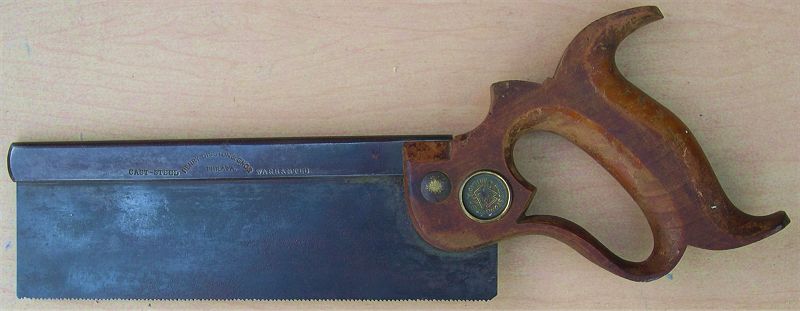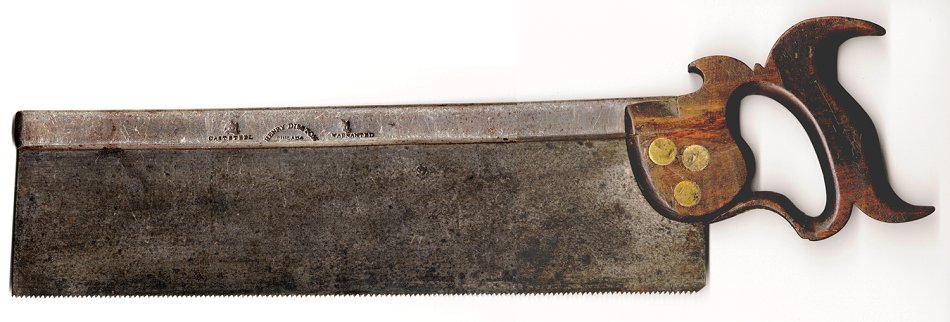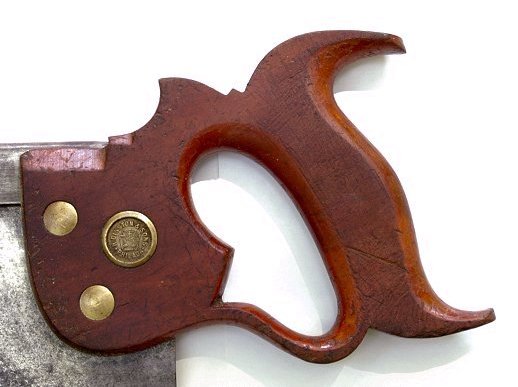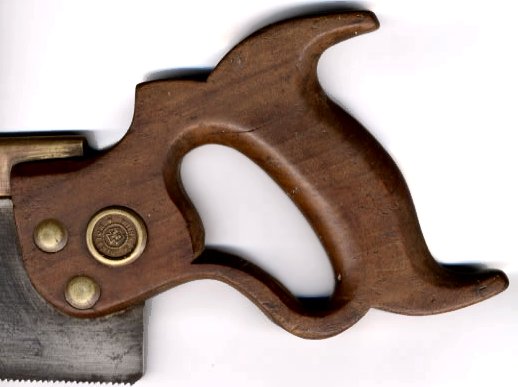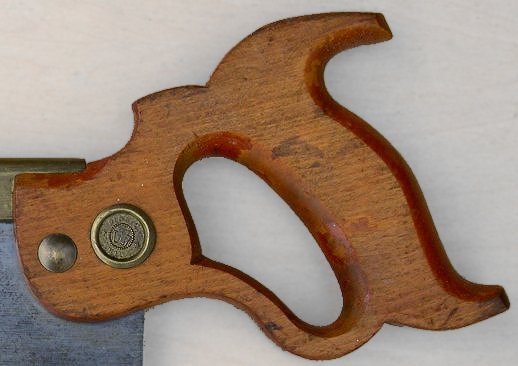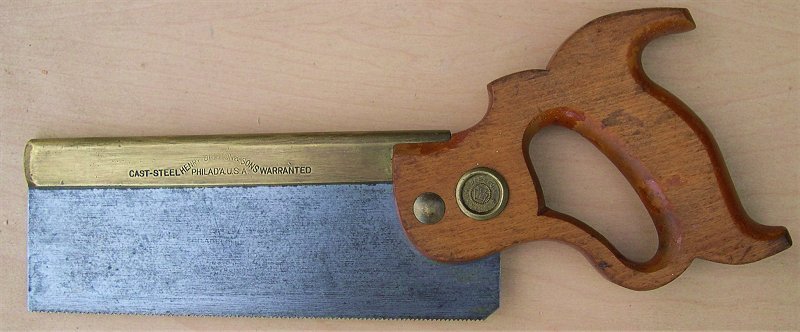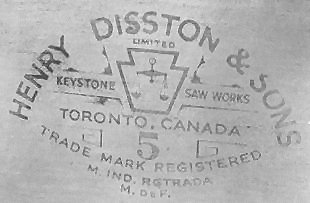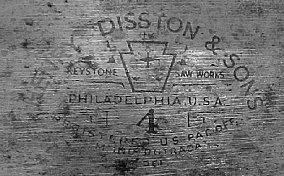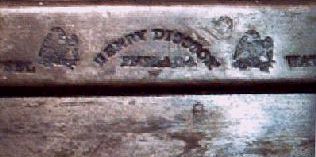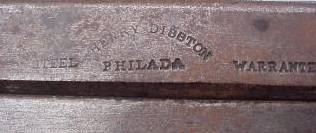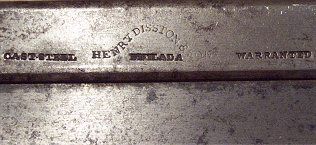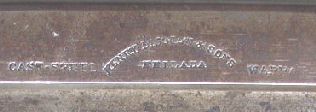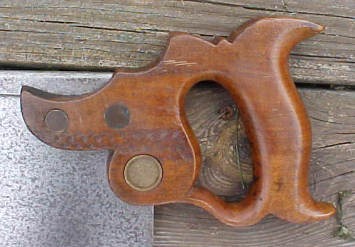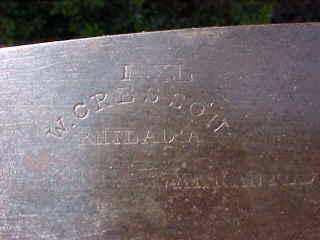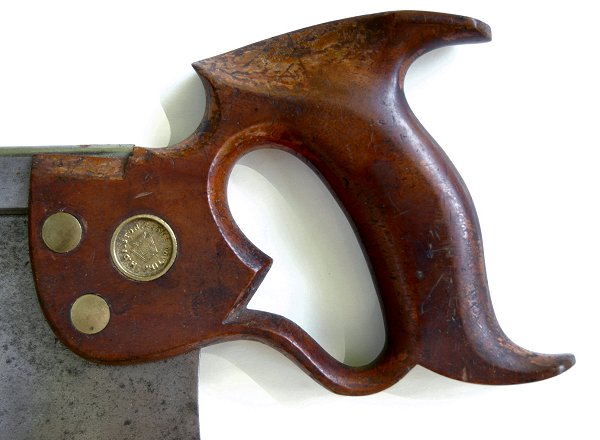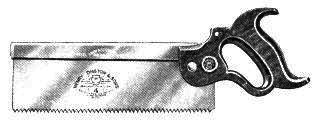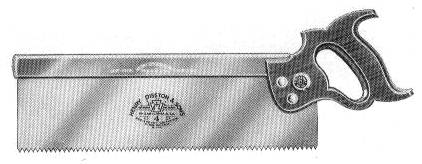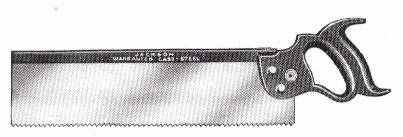Information taken from Disston 1876 catalog:

No. 4. Disston and Sons, Apple Handle, Polished Edges, Blue
Back.
| 8 |
10 |
12 |
14 |
16 |
18 |
inches |
| $14.00 |
1.00 |
18.00 |
21.00 |
24.00 |
27.00 |
per dozen |
No. 5. Disston and Sons, as No. 4, Brass Back.
| 8 |
10 |
12 |
14 |
16 |
18 |
inches |
| $18.00 |
19.00 |
22.00 |
25.00 |
29.00 |
33.00 |
per dozen |
No. 7. Disston and Sons, as No. 4, with Polished Steel Back.
| 8 |
10 |
12 |
14 |
16 |
18 |
inches |
| $15.50 |
16.50 |
20.00 |
23.00 |
26.50 |
30.00 |
per dozen |

Gent's Half-Back Bench Saw
| 14 |
16 |
18 |
20 |
inches |
| $18.00 |
21.00 |
24.00 |
27.00 |
per dozen |
Information taken from Disston 1890 catalog:

Henry Disston and Sons' Cast-Steel Back Saw
No. 4. Disston and Sons Apple Handle, Polished Edge, Blue Back.
| 8 |
10 |
12 |
14 |
16 |
18 |
inches |
| $13.00 |
14.00 |
16.00 |
18.00 |
20.00 |
22.00 |
per dozen |

Henry Disston and Sons' Steel Back Mitre Box Saw
No. 4. Disston and Sons Apple Handle, Polished Edge, Blue Back.
4 Inches Under Back
| 18 |
20 |
22 |
24 |
26 |
28 |
30 |
inches |
| $22.00 |
24.00 |
26.00 |
28.00 |
30.00 |
32.00 |
34.00 |
per dozen |
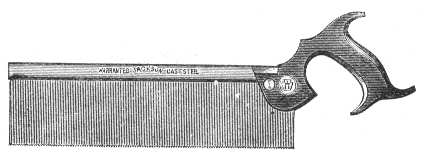
Jackson Cast-Steel Back Saw
| 8 |
10 |
12 |
14 |
16 |
18 |
20 |
22 |
24 |
inches |
| $9.00 |
10.00 |
12.00 |
14.00 |
16.00 |
18.00 |
20.00 |
22.00 |
24.00 |
per dozen |
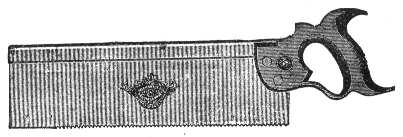
No. 77 Backsaw, Disston and Sons' MECHANICS' OWN
To Run Without Set
| 8 |
10 |
12 |
14 |
16 |
18 |
20 |
22 |
24 |
26 |
inches |
| $16.00 |
18.00 |
20.00 |
22.00 |
25.00 |
28.00 |
31.00 |
34.00 |
37.00 |
40.00 |
per dozen |
If you cannot be supplied through your dealer, write
us.
Information taken from Disston 1906
catalog:
DISSTON
CRUCIBLE CAST-STEEL BACK SAWS
Made with Rip Teeth when specially ordered.

No. 4. Apple Handle, Polished Edge, Blued-back.
| 8 |
10 |
12 |
14 |
16 |
18 |
inches |
| $13.00 |
14.00 |
16.00 |
18.00 |
20.00 |
22.00 |
per dozen |
No. 5. With Brass Back.
| 8 |
10 |
12 |
14 |
16 |
18 |
inches |
| $18.00 |
19.00 |
21.00 |
23.00 |
26.00 |
30.00 |
per dozen |
No. 7. With Polished Steel Back.
| 8 |
10 |
12 |
14 |
16 |
18 |
inches |
| $14.00 |
15.00 |
17.00 |
19.00 |
21.00 |
23.00 |
per dozen |
DISSTON
MITRE-BOX SAW, No. 4.
| Made in Disston Quality only,
as they require to be very accurate to give satisfactory
service. |
 |
|
Crucible Steel Blade, Apple Handle,
Polished Edge, Steel Back.
The following prices are for saws measured
the full length of the blade. The peculiar shape of butt or heel in
these saws makes the toothed edge about 2 inches shorter than the
full length of the blade. Mitre-Box Saws are regularly made 11
points to the inch.
|
|
4 |
5 |
6 |
inches under back |
| 20 inches |
$24.00 |
|
price per dozen |
| 22 |
26.00 |
28.50 |
31.00 |
" |
| 24 |
28.00 |
31.00 |
34.00 |
" |
| 26 |
30.00 |
33.50 |
37.00 |
" |
| 28 |
32.00 |
36.00 |
40.00 |
" |
| 30 |
34.00 |
38.50 |
43.00 |
" |
| 32 |
36.00 |
41.00 |
46.00 |
" |
Information taken from Disston 1911
catalog:
BACK SAWS
CRUCIBLE STEEL
DISSTON BACK SAW, No. 4
Made with Rip Teeth when specially ordered.

No. 4. Apple Handle, Polished Edge, Blued-back.
| 8 |
10 |
12 |
14 |
16 |
18 |
inches |
| $13.00 |
14.00 |
16.00 |
18.00 |
20.00 |
22.00 |
per dozen |
No. 5. With Brass Back.
| 8 |
10 |
12 |
14 |
16 |
18 |
inches |
| $18.00 |
19.00 |
21.00 |
23.00 |
26.00 |
30.00 |
per dozen |
No. 7. With Polished Steel Back.
| 8 |
10 |
12 |
14 |
16 |
18 |
inches |
| $14.00 |
15.00 |
17.00 |
19.00 |
21.00 |
23.00 |
per dozen |
MITRE-BOX SAW, No. 4
| Made in Disston Quality only,
as they require to be very accurate to give satisfactory
service. |
 |
|
Crucible Steel Blade, Apple Handle,
Polished Edge, Steel Back.
The following prices are for saws measured
the full length of the blade. The peculiar shape of butt or
heel in these saws makes the toothed edge about 2 inches shorter
than the full length of the blade. Mitre-Box Saws are regularly
made 11 points to the inch.
|
|
4 |
5 |
6 |
inches under back |
| 20 inches |
$24.00 |
|
price per dozen |
| 22 |
26.00 |
28.50 |
31.00 |
" |
| 24 |
28.00 |
31.00 |
34.00 |
" |
| 26 |
30.00 |
33.50 |
37.00 |
" |
| 28 |
32.00 |
36.00 |
40.00 |
" |
| 30 |
34.00 |
38.50 |
43.00 |
" |
| 32 |
36.00 |
41.00 |
46.00 |
" |
Packed one-third dozen in box.
Trade mark
Registered
U.S. Pat. Off. |
 |
"Jackson" Backsaw, No. 1
Beech Handle, Polished, Blued Back.
| 8 |
10 |
12 |
14 |
16 |
18 |
inches |
| $9.00 |
10.00 |
12.00 |
14.00 |
16.00 |
18.00 |
per dozen |
Packed one-third dozen in box.

"Davis" Back Saw, No. 0
Beech Handle, Polished Edge, 10 and 12-inch made with
open Handle, 14-inch with closed Handle. All sizes made 12 point
only.
| 10 |
12 |
14 |
inches |
| $8.00 |
9.00 |
10.00 |
per dozen |
Packed one-third dozen in box.
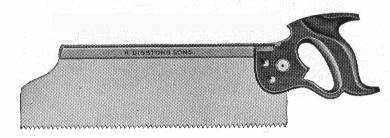
Improved Back Saw, No. 9
| 10 |
12 |
14 |
16 |
18 |
inches |
| 14.50 |
16.50 |
18.50 |
20.50 |
22.50 |
per dozen |
Packed one-third dozen in box.

"MECHANICS' OWN" Back Saw, No. 77
To Run Without Set
| 8 |
10 |
12 |
14 |
16 |
18 |
20 |
22 |
24 |
26 |
inches |
| $16.00 |
18.00 |
20.00 |
22.00 |
25.00 |
28.00 |
31.00 |
34.00 |
37.00 |
40.00 |
per dozen |
Packed one-third dozen in box.
Information taken from Disston 1914
catalog:
BACK SAWS
CRUCIBLE STEEL
DISSTON BACK SAW, No. 4
Made with Rip Teeth when specially ordered.

No. 4. Apple Handle, Polished Edge, Blued-back.
| 8 |
10 |
12 |
14 |
16 |
18 |
inches |
| $13.00 |
14.00 |
16.00 |
18.00 |
20.00 |
22.00 |
per dozen |
No. 5. With Brass Back.
| 8 |
10 |
12 |
14 |
16 |
18 |
inches |
| $18.00 |
19.00 |
21.00 |
23.00 |
26.00 |
30.00 |
per dozen |
No. 7. With Polished Steel Back.
| 8 |
10 |
12 |
14 |
16 |
18 |
inches |
| $14.00 |
15.00 |
17.00 |
19.00 |
21.00 |
23.00 |
per dozen |
BACK SAWS FOR CUTTING METAL, No. 4 pattern, advance 25% on list of
No. 4.
BACK SAWS FOR CUTTING KALOMINE, same price as No. 4.
Packed one-third dozen in box.
MITRE-BOX SAWS
Made in Disston Quality
only, their accuracy and efficiency is recognized by the
prominent manufacturers of Mitre Boxes as Standard.
DISSTON MITRE-BOX SAW, No.
4
|
 |
|
Crucible Steel Blade, Apple Handle,
Polished Edge, Blued Back.
The following prices are for saws measured
the full length of the blade. The peculiar shape of butt or
heel in these saws makes the toothed edge about 2 inches shorter
than the full length of the blade. Mitre-Box Saws are regularly
made 11 points to the inch, 19 gauge in thickness.
|
|
4 |
5 |
6 |
inches under back |
| 20 inches |
$24.00 |
|
price per dozen |
| 22 |
26.00 |
28.50 |
31.00 |
" |
| 24 |
28.00 |
31.00 |
34.00 |
" |
| 26 |
30.00 |
33.50 |
37.00 |
" |
| 28 |
32.00 |
36.00 |
40.00 |
" |
| 30 |
34.00 |
38.50 |
43.00 |
" |
| 32 |
36.00 |
41.00 |
46.00 |
" |
Packed one-third dozen in box.
Information taken from Disston 1918
catalog:
BACK SAWS
CRUCIBLE STEEL
DISSTON BACK SAW, No. 4
Made with Rip Teeth when specially ordered at the same price.

No. 4. Apple Handle, Polished Edge, Brass Screws, Blued Back.
| 8 |
10 |
12 |
14 |
16 |
18 |
inches |
| $13.00 |
14.00 |
16.00 |
18.00 |
20.00 |
22.00 |
per dozen |
No. 5. With Brass Back.
| 8 |
10 |
12 |
14 |
16 |
18 |
inches |
| $18.00 |
19.00 |
21.00 |
23.00 |
26.00 |
30.00 |
per dozen |
No. 7. With Polished Steel Back.
| 8 |
10 |
12 |
14 |
16 |
18 |
inches |
| $14.00 |
15.00 |
17.00 |
19.00 |
21.00 |
23.00 |
per dozen |
Packed one-third dozen in box.
|
MITRE-BOX SAWS
Made in Disston Quality only, their
accuracy and efficiency is recognized as The Standard by the
prominent manufacturers of Mitre Boxes.
DISSTON MITRE-BOX SAW, No.
4
|
 |
|
Crucible Steel Blade, Apple Handle,
Polished Edge, Blued Back.
The following prices are for saws measured
the full length of the blade. The peculiar shape of butt or
heel in these saws makes the toothed edge about 2 inches shorter
than the full length of the blade. Mitre-Box Saws are regularly
made 11 points to the inch, 19 gauge in thickness.
|
|
4 |
5 |
6 |
inches under back |
| 20 inches |
$24.00 |
|
price per dozen |
| 22 |
26.00 |
28.50 |
31.00 |
" |
| 24 |
28.00 |
31.00 |
34.00 |
" |
| 26 |
30.00 |
33.50 |
37.00 |
" |
| 28 |
32.00 |
36.00 |
40.00 |
" |
| 30 |
34.00 |
38.50 |
43.00 |
" |
| 32 |
36.00 |
41.00 |
46.00 |
" |
Packed one-third dozen in box.
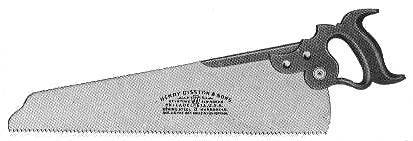
Half-Back Bench Saw, No. 8
Brass Back
Apple Handle, Polished Edge, Brass Screws, Brass Back.
Combining the advantages of a Hand Saw and a Back Saw.
| 14 |
16 |
18 |
20 |
inches |
| $18.00 |
21.00 |
24.00 |
27.00 |
per dozen |
Packed one-third dozen in box.

Improved Back Saw, No. 9
| 10 |
12 |
14 |
16 |
18 |
inches |
| 14.50 |
16.50 |
18.50 |
20.50 |
22.50 |
per dozen |
Packed one-third dozen in box.
Trade mark
Registered
U.S. Patent Office. |
 |
"Jackson" Backsaw, No. 1
Beech Handle, Polished, Blued Back.
| 8 |
10 |
12 |
14 |
16 |
18 |
inches |
| $9.00 |
10.00 |
12.00 |
14.00 |
16.00 |
18.00 |
per dozen |
Packed one-third dozen in box.

"Davis" Back Saw, No. 0
Beech Handle, Polished Edge, 10 and 12-inch made with
open Handle, 14-inch with closed Handle. All sizes made 12 point
only.
| 10 |
12 |
14 |
inches |
| $8.00 |
9.00 |
10.00 |
per dozen |
Packed one-third dozen in box.

Back Saw, No. 14
Nickel-Plated Lever Tightener and Wing Nut
Patented Jan. 27, 1914

